When the Korean War broke out, the USS Missouri was the only battleship still in active service with the US Navy. She was President Truman's favorite ship, because she'd been sponsored by his daughter and named after his home state, and he'd kept her active against the advice of the military establishment. Even her grounding on Thimble Shoal was not enough to persuade him to retire her1 and this proved fortuitous when the Korean War broke out in June of 1950, the North Korean assault sending the South Koreans reeling back to a small corner of the country near Pusan.
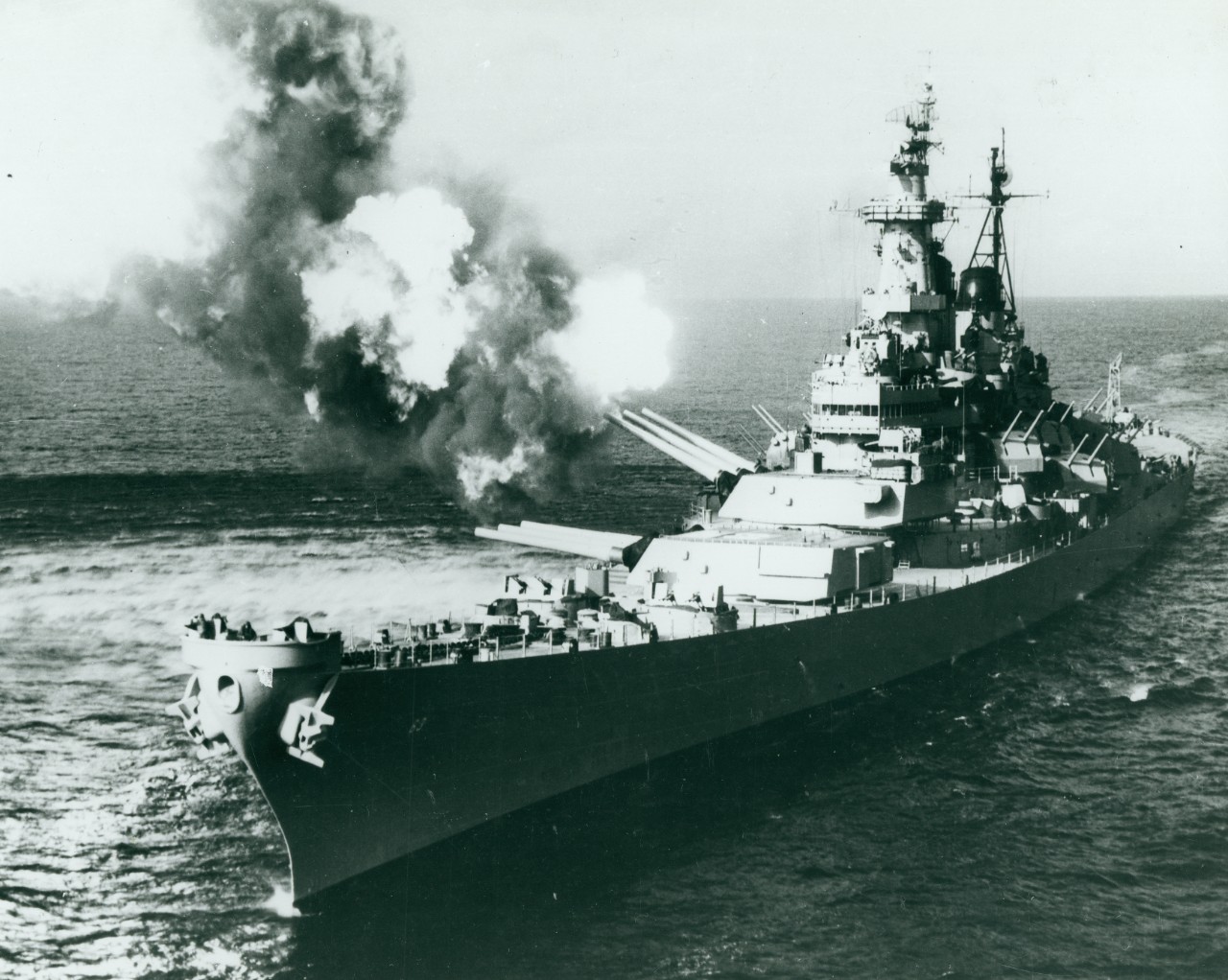
Missouri bombarding targets in Korea
When the invasion began, Missouri was on a training cruise. Initially the training schedule continued despite the war, but in August, she was ordered to drop the midshipmen off and hurry to Korea, to support the upcoming invasion of Inchon. On the way, she encountered a hurricane which did enough damage to require a week in Pearl Harbor for repair and swept several helicopters over the side. On a training shoot in Hawaii, a mistake with the fire control system resulted in a constant range going to the guns, which missed the island they were shooting at entirely.
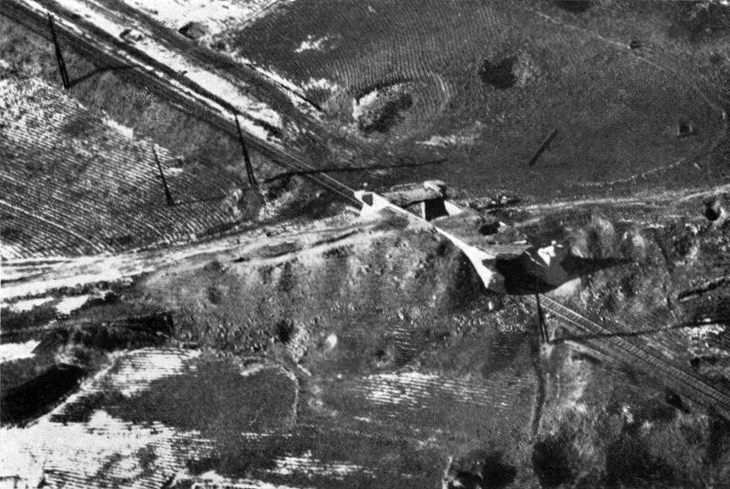
The effects of Missouri's shells on the Korean coast
On September 15th, Missouri went into action against targets on the east coast of Korea, soon proving her effectiveness, and opening the way for her sisters to be reactivated to replace her on the gunline.2 However, the early weeks were also marred by some rather humorous problems. Many shells had faulty fuses which detonated a second or so after firing, occasionally leaving fragments on the deck of the battleship. At one point, radar detected what appeared to be a large flotilla of torpedo boats approaching at 40 kts. When they finally entered visual range, they were identified as geese.
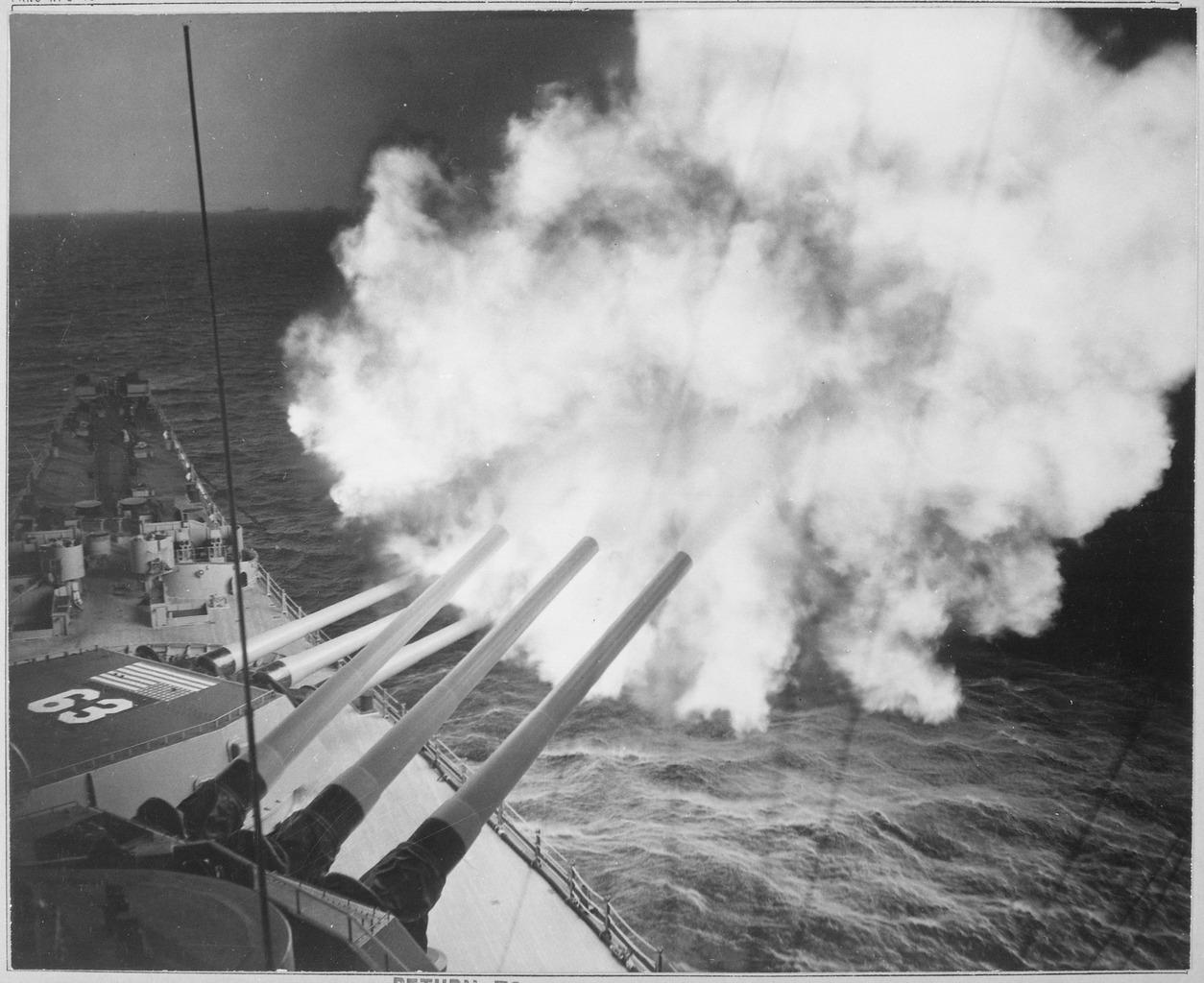
Missouri firing on Hungnam
In early November, as the United Nations approached the Yalu River, the Chinese sent their armies surging south. Missouri covered the final withdrawal from the Chosin Reservoir at the Port of Hungnam during the bitterly cold winter of 1950-1951. In some cases, snow fell on the ship's deck, leading to snowball fights among the crew. In the new year, things settled down, falling into the routine that Missouri and her sisters would follow for the next two and a half years. By the time she returned home in mid-March, Missouri had fired 2,895 rounds of 16", and 8,043 rounds of 5".
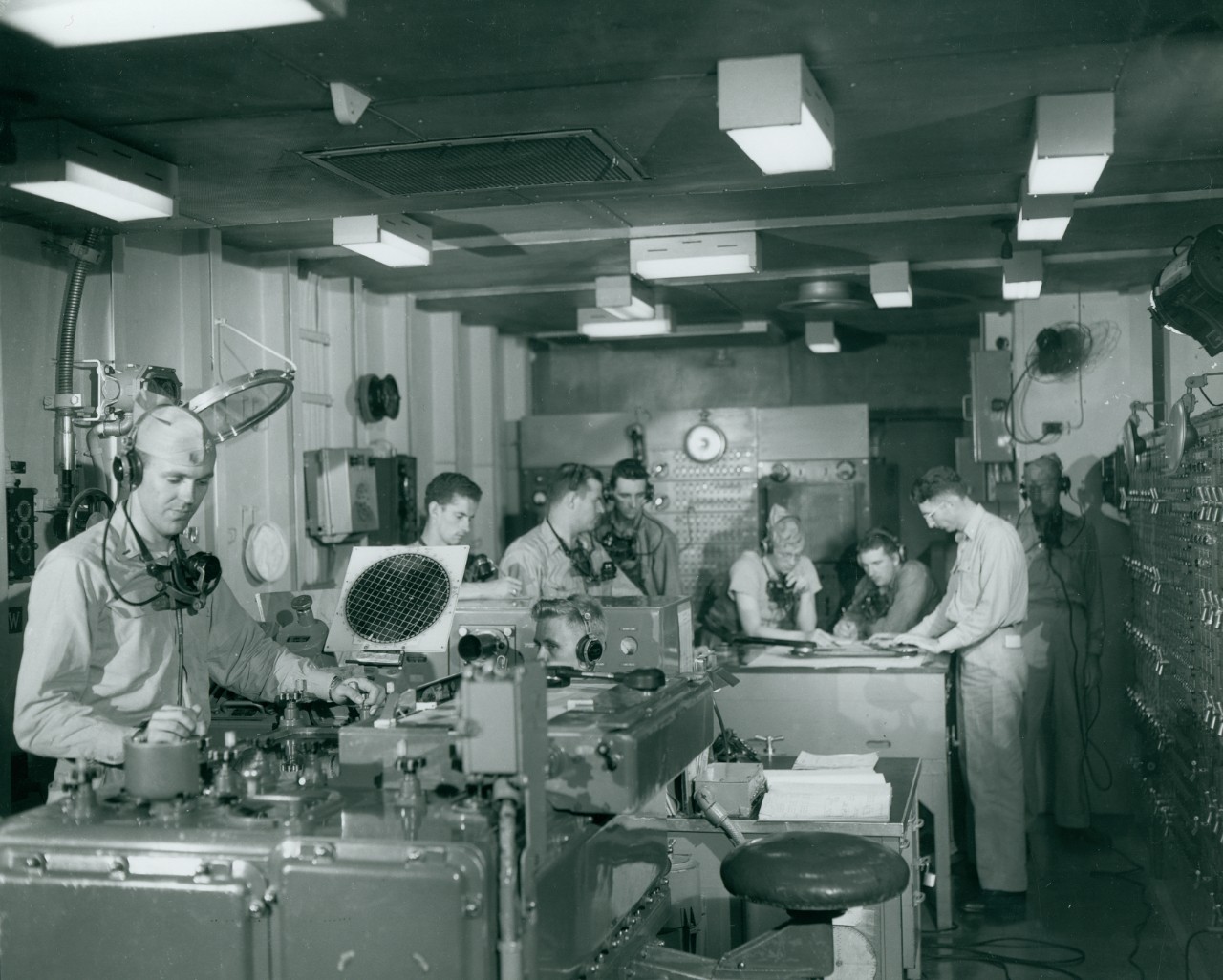
Missouri's Main Battery Plot while firing off Korea
Missouri spent the next year and a half on the usual round of training duties, before reappearing to relieve Iowa off Korea in October 1952. Her deployment lasted through late March, following the standard pattern of battleship operations off Korea, before she was relieved by New Jersey. The day after her last combat mission, her captain, Warner Edsall, suffered a heart attack and died on the bridge. She spent the next two years on training duty before becoming the first of the four ships to leave active service during the 1950s. She was sailed to Bremerton, Washington, and decommissioned on February 26th, 1955.3
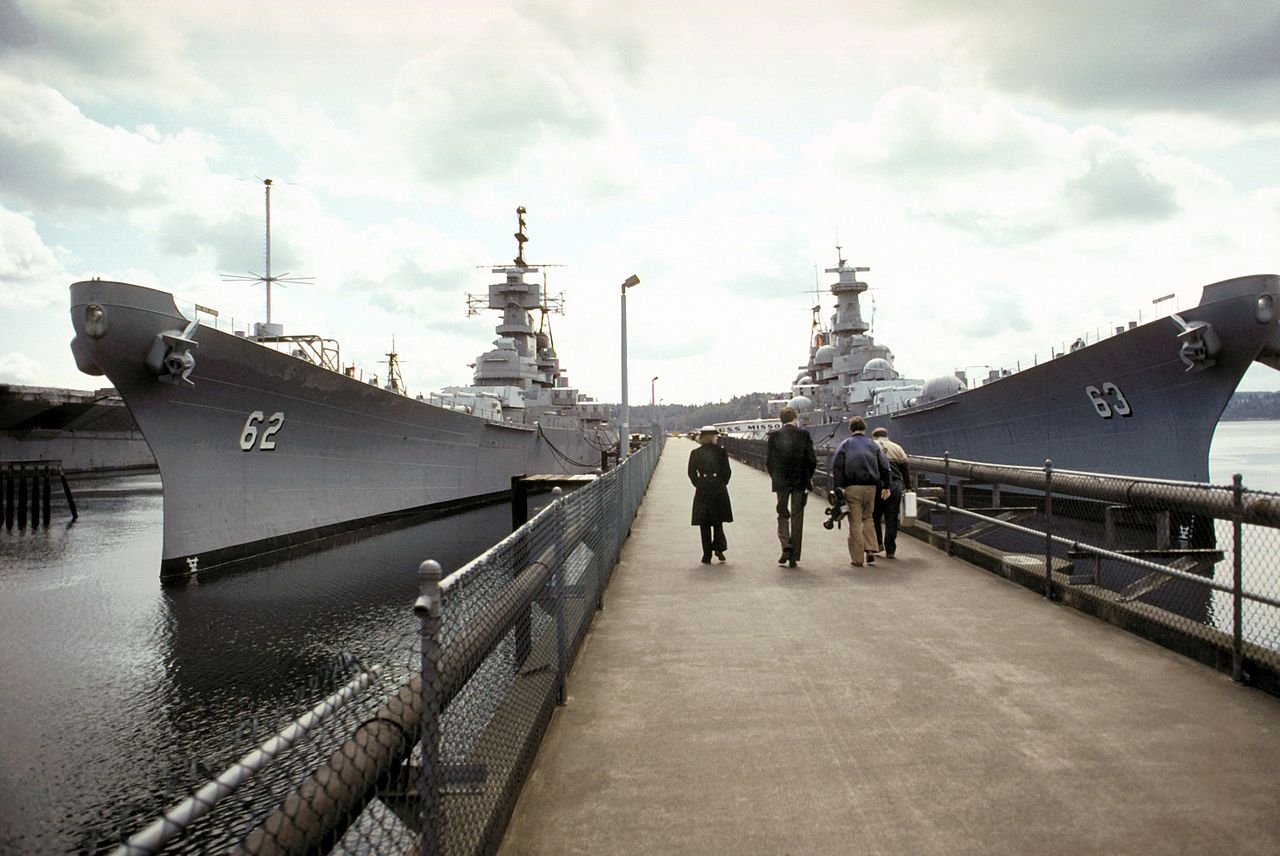
Missouri and New Jersey in mothballs, 1981
She was a major tourist attraction in Bremerton for the next three decades, waiting for the call. Besides hosting tourists who wanted to see where WWII had ended, she also played host to several film productions, most notably the movie MacArthur, which saw the surrender ceremony replicated where it had originally taken place. But then came the Reagan Administration and the 600-ship Navy, and in May 1984, she was towed south to Long Beach Naval Shipyard, to be reactivated by the same crew that had placed New Jersey back in commission.
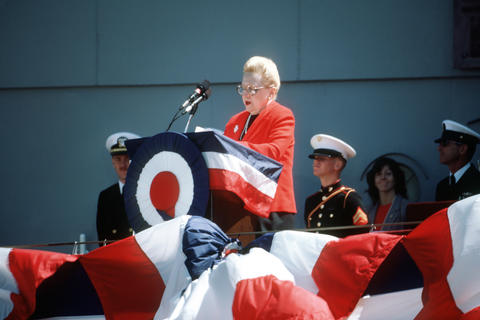
Margaret Truman Daniels speaking at Missouri's recommissioning
Two years later, on May 10th, 1986, Missouri was recommissioned in San Francisco, which would be her new homeport.4 However, she quickly returned to the Long Beach area, as she had more working-up to do before her first cruise. After four months of training, she departed on an around-the-world cruise, the first American battleship to do so since the Great White Fleet which had included the previous Missouri. On the first leg to Hawaii, a plate fell into the reduction gears in Engine One, and the engine was out of action for several weeks until the gears were repaired by the crew.
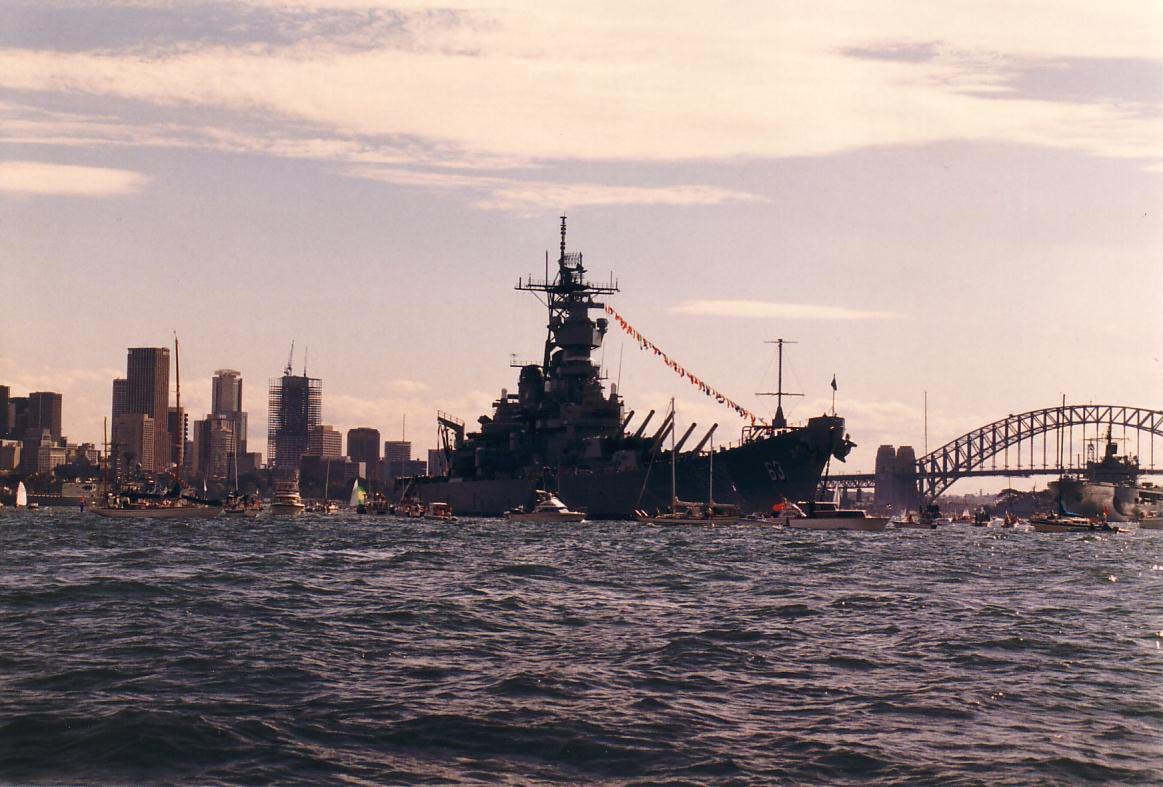
Missouri in Sydney Harbor
Missouri's next stop was Sydney, where the 75th Anniversary of the Royal Australian Navy was being celebrated. On the way, she crossed the equator at the international date line, allowing the crew to become "golden shellbacks". The man who played King Neptune, Master Chief Davidson, had been onboard in 1947, when the ship crossed the equator with Truman onboard. Australia welcomed Missouri with enthusiasm, with an estimated quarter-million people showing up on the day the battleship was opened to the public. The open house was cut short out of safety concerns after a dozen or so women fainted and had to be passed over the crowd to the wardroom. One of them was pregnant, and there was concern about what would happen if she were to give birth. Missouri was sovereign US territory, and the baby might be considered a US citizen. However, the worries were premature, and the expectant mother was quickly removed ashore. The liberty parties received a similar welcome, and men from other ships soon began wearing Missouri patches to cash in on the goodwill.
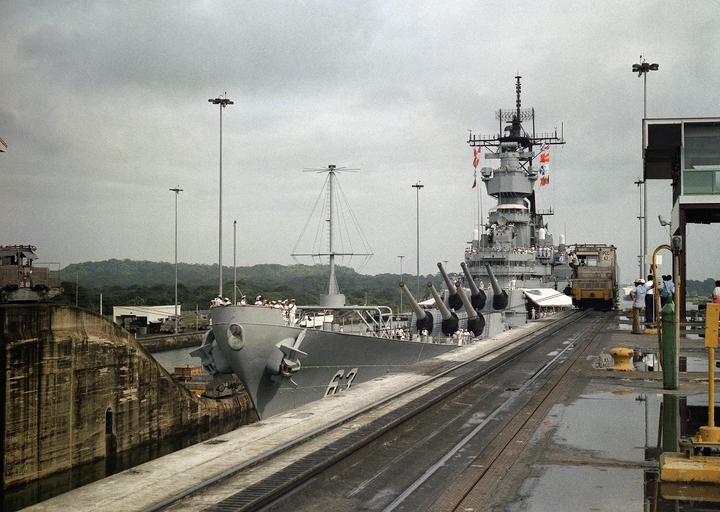
Missouri entering the Gatun Locks
After Sydney, Missouri headed for Perth, and then on to the Indian Ocean. She passed through the Suez Canal for the only time in her career, then headed for Turkey, to commemorate her visit four decades earlier. She cruised the length of the Mediterranean, trailed by a Soviet frigate, then passed into the Atlantic for the first time in 30 years. On the way through the Panama Canal, the tugs didn't line her up properly, and the captain claimed that the resulting scraping sounded like 10,000 fingers on a blackboard. Still, no lasting damage was done, and the battleship reached Long Beach in time for Christmas.
After some time in the yard and training up and down the California coast, Missouri was dispatched to the Middle East to support Operation Earnest Will, the protection of oil tankers from the depredations of the Iran-Iraq War. In October, she escorted her first convoy through the Strait of Hormuz. There was serious concern that the Iranians would attack, but they were sufficiently cowed by the naval force assembled to let not only this convoy, but all convoys escorted by battleships, through unmolested.
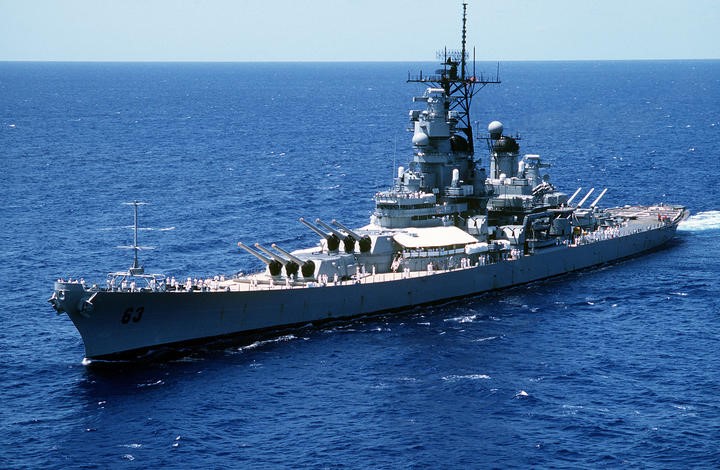
Missouri underway in 1987
After over 100 days without a port visit, Missouri arrived at Diego Garcia. One of the officers had been concerned about his men who didn't get mail, and had written to Dear Abby asking that readers send letters to the crew. They found four tractor-trailers full of mail waiting for them as a result of the mention in the column, making everyone except the postal clerks very happy. They had to hold mail call six times a day, and eventually began sending the mailbags to the public affairs office after they learned that the PAO was responsible for the avalanche of mail.
From Diego Garcia, Missouri returned to Sydney just in time for Christmas. The citizens of that city welcomed the battleship just as they had a year earlier, and so many families offered to open their homes that sailors were assigned one family to visit on Christmas Eve and another for Christmas Day.
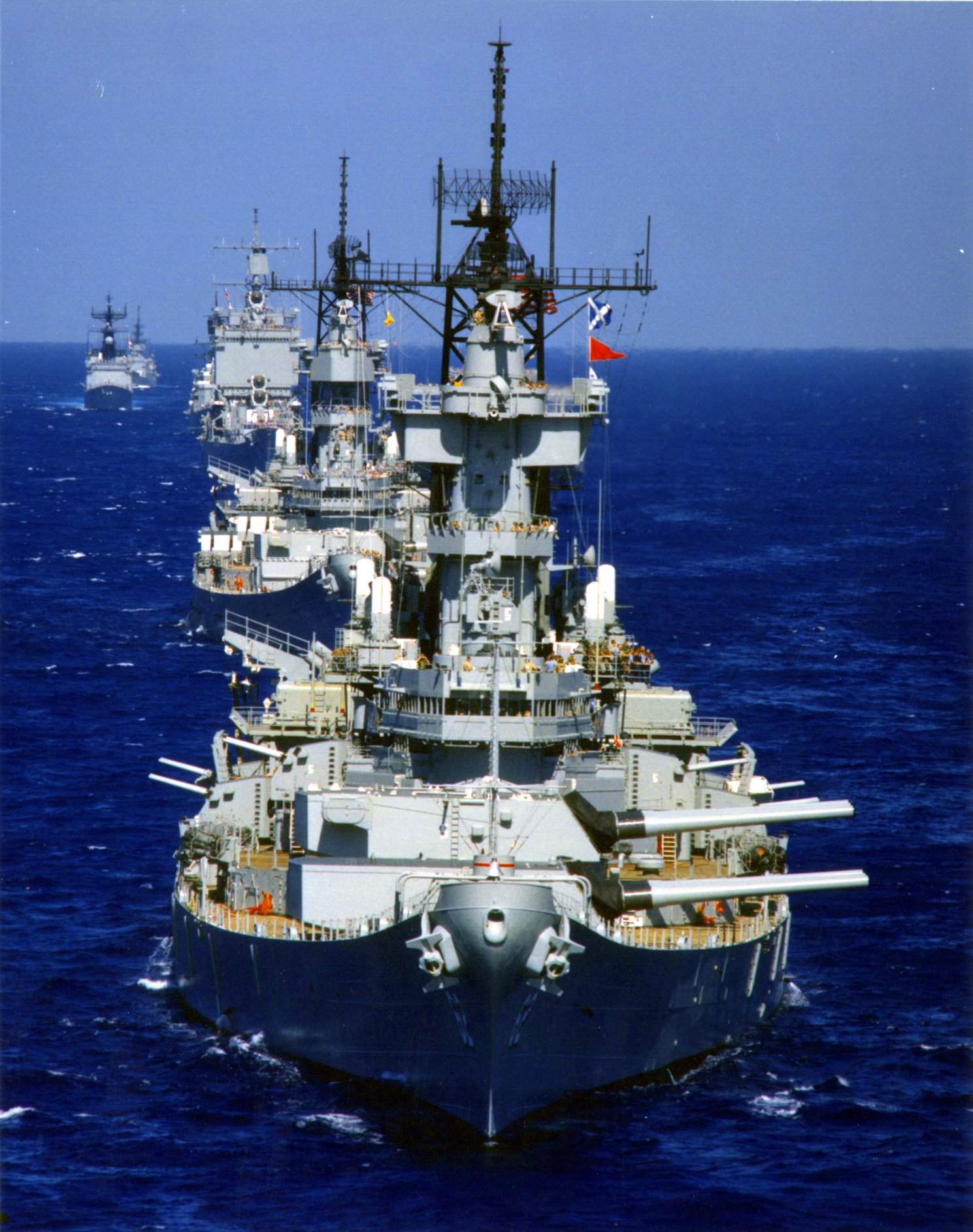
New Jersey leads Missouri and missile cruiser Long Beach during RimPac 88
1988 was mostly spent in the Eastern Pacific. She participated in RimPac 88, a large multinational exercise with the New Jersey, visited Vancouver, and fired her first Tomahawk. 1989 was also fairly quiet, with the greatest excitement being the filming of the music video for Cher's "If I Could Turn Back Time". This provoked controversy, due to the singer's provocative choice of clothing, which was not what she had told the Navy she planned to wear. However, the Missouri's crew embraced the song, and used it during underway replenishment from then on.5 The year was also marred by the explosion aboard Iowa, and to reassure the crew when the ban on firing the main guns was lifted, the Captain fired the center gun of Turret II himself from inside the turret. Missouri also pioneered an onboard computer network, known as MONET, and the use of ATMs onboard a warship.

Missouri in drydock at Long Beach, 1990
1990 saw Missouri participating in another RimPac. During this exercise, she gave an excellent demonstration of the ability of ships to deceive those looking for them. She split off from her escorts at night, turned off her radars, and set up lighting to make her look like a tanker, and set a steady course and speed. As a result, the planes looking for her flew right past, and she arrived within gun range of the amphibious group she was hunting before they had an inkling that she was in the area. However, the days of the battleship were obviously numbered, and it had already been announced that Missouri would deactivate after her next deployment when Saddam Hussein sent his army into Kuwait at the beginning of August.
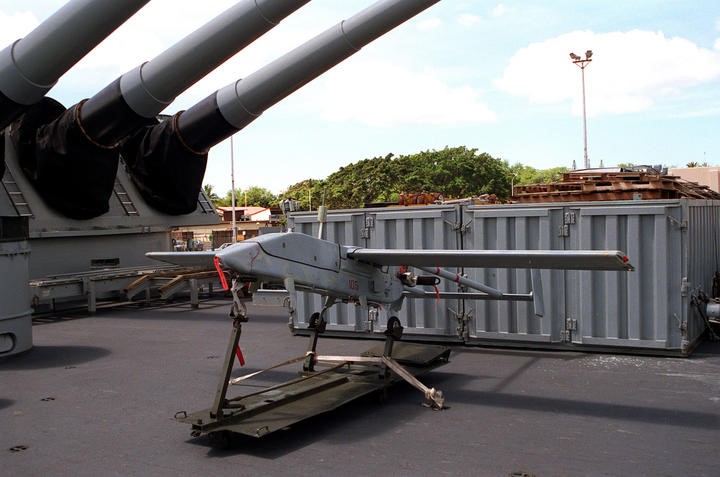
A Pioneer aboard Missouri
Missouri's crew swiftly prepared the ship for action, most notably taking aboard a detachment for the operation of Pioneer UAVs and another for explosive ordnance disposal. They departed for the Persian Gulf in mid-November. As Wisconsin had deployed earlier and would return home sooner, this would almost certainly be the last deployment of the last battleship, and the ship's sailing was carried live on CNN. On January 9th, the EOD team blew up their first mine, sobering the crew.
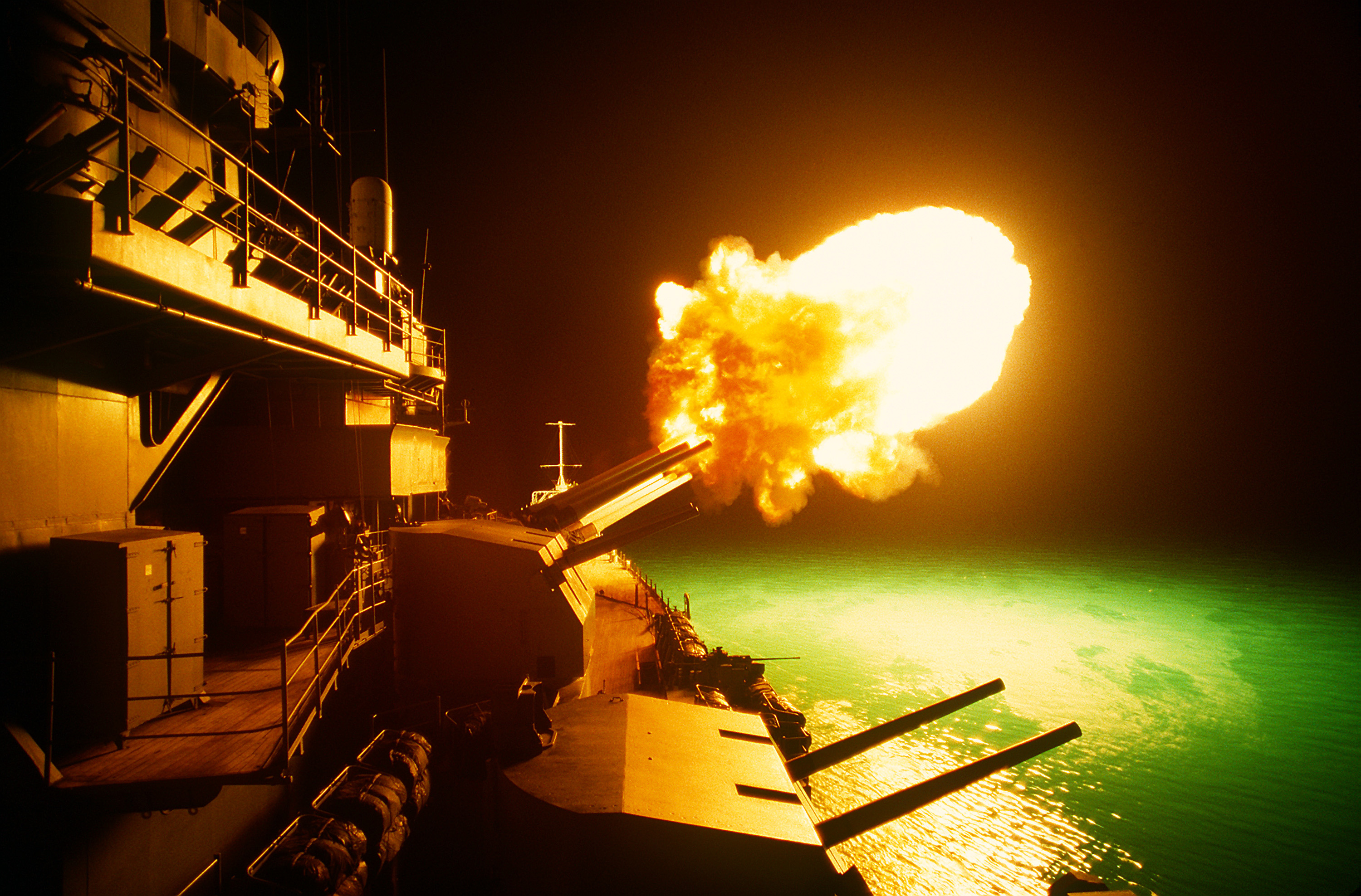
Missouri firing on Iraqi positions during Desert Storm
On the 17th, Desert Shield became Desert Storm, and Missouri was an important part of the initial strike plan. At 0140, the first Tomahawk erupted from the box launchers headed for Baghdad, followed shortly by five more. 22 more were launched over the next three days, before the ship shifted into reserve. Saddam's air defenses had been destroyed, and the air war had shifted to destroying his ground forces. But the battle of Khafji on February 1st brought her back into play. The Iraqis had apparently attempted to invade Saudi Arabia, and while they had been turned back, the Coalition commanders decided to teach them a lesson. On February 3rd, Missouri's guns spoke in anger for the first time in almost 40 years. She had to come in very close to shore, and at one point, the fathometer reported only 3' of water under the keel. The Pioneer was able to provide excellent spotting, and the video was sent over the ship's TV system, boosting morale. The first three days of firing saw 112 shells land on Khafji, followed by 60 more a week later.
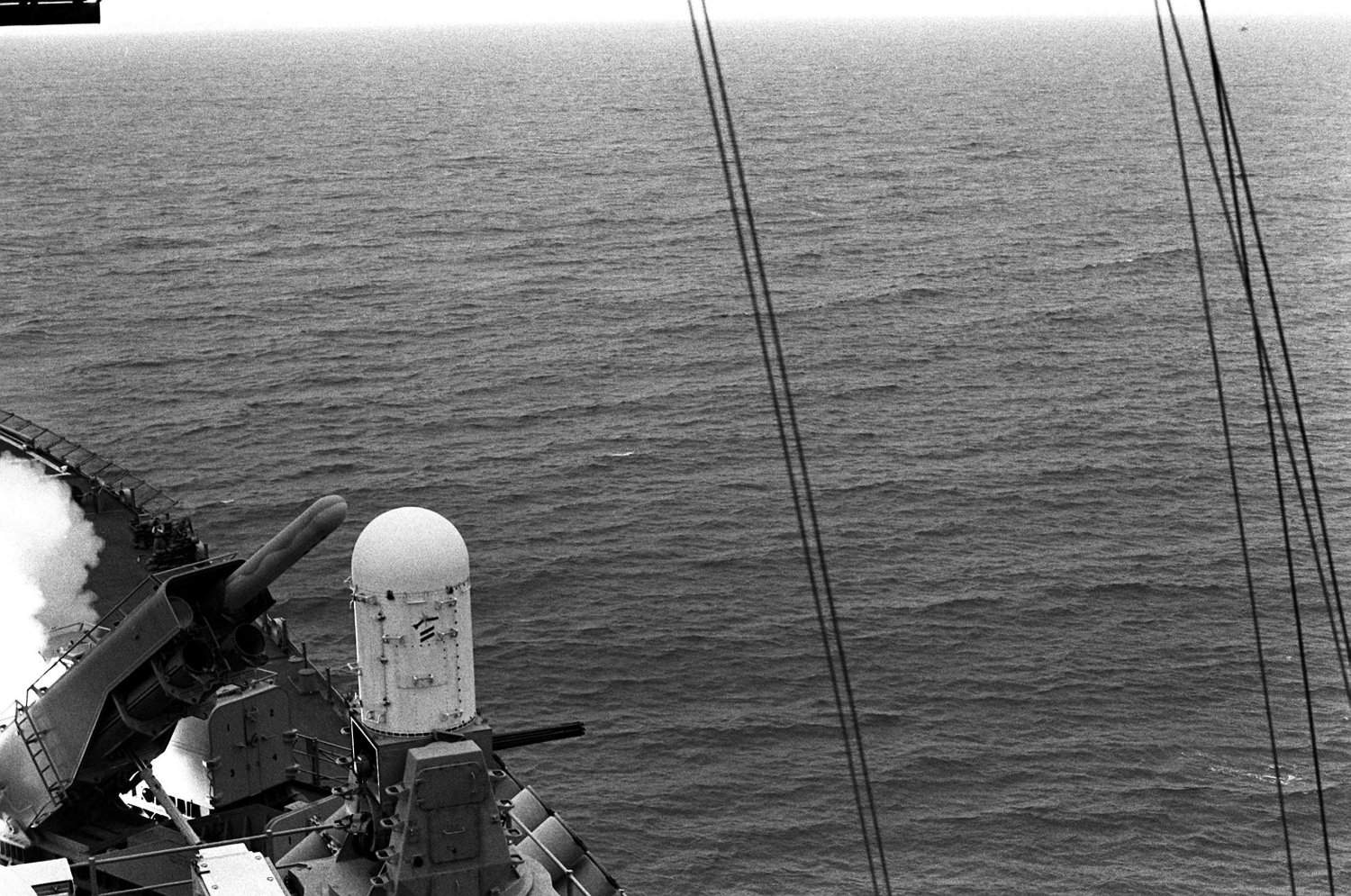
Missouri firing a Tomahawk at Iraq
On February 13th, Missouri moved north as part of the Coalition's diversionary strategy. Marines aboard amphibious ships in the Gulf threatened Iraq's seaboard flank, and every man facing them was one who could not oppose the armored sweep scheduled to kick off on the 24th. It took 10 days for the mine warfare team to clear a firing position, and the available box was only about a mile long, forcing frequent changes of course.
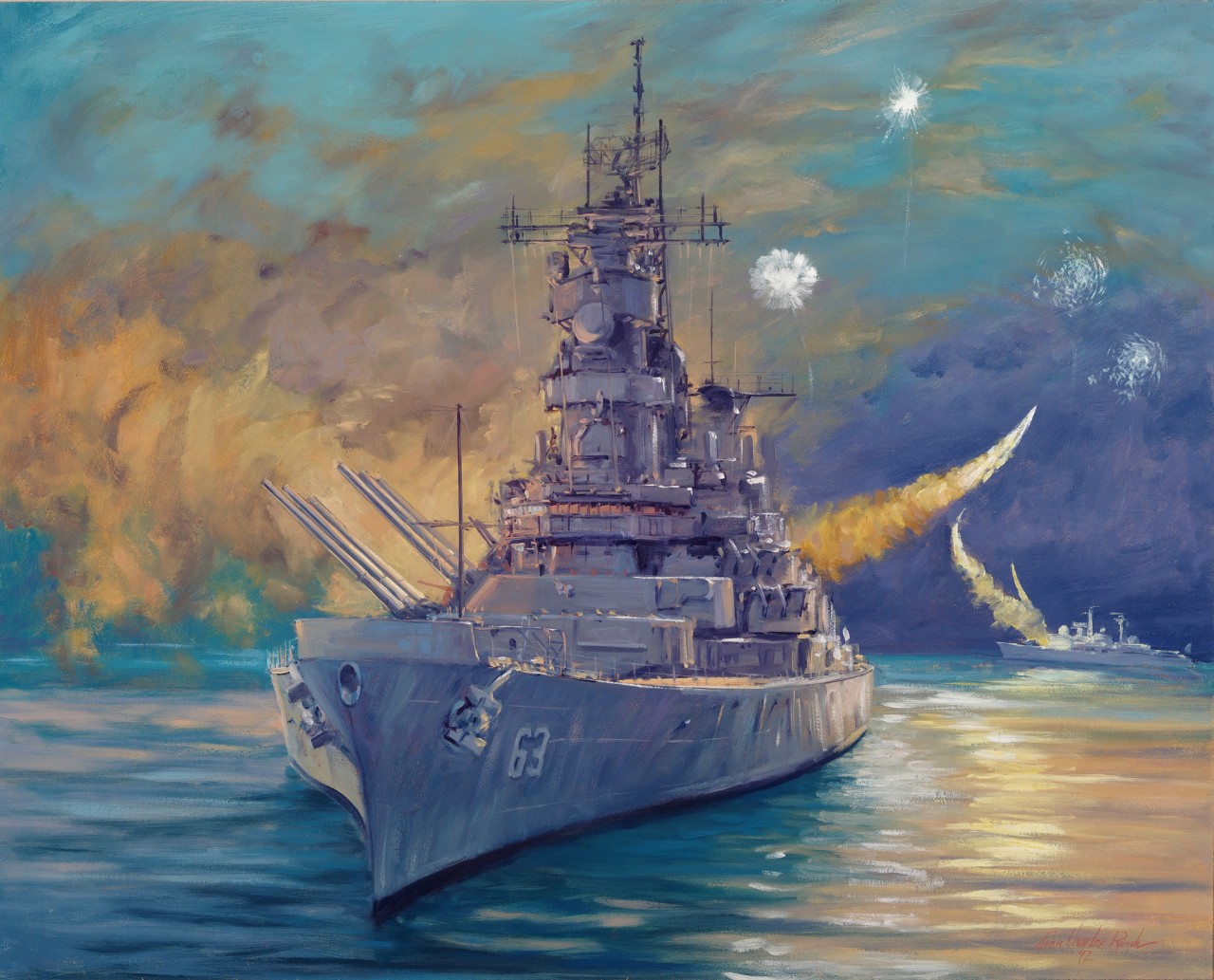
Gloucester shooting down the Silkworm that missed Missouri
The ship opened fire on the 23rd, doing her best to convince the Iraqis that she was preparing the way for a landing. They took it seriously enough to respond in the early hours of the next morning, firing a Chinese-made Silkworm missile at her. It appears that the missile was never armed, and it passed safely clear of Missouri. One of her escorts, the British destroyer Gloucester, had detected the battery radar, and her combat system immediately began to plan to engage the missile. A maneuver to bring her weapons into the optimum firing angle would have taken the destroyer into mine-infested waters, so she fired her Sea Darts in what was described as "an over-the-shoulder, round-the-corner shot". The first Sea Dart took out the Silkworm, while the second flew through its wreckage, a truly incredible performance from a ship that spent more time in hostile waters than any other vessel in the war. A UAV quickly found the battery, and Missouri promptly pounded it to pieces.

Missouri pounding Iraqi targets
A few hours later, another missile alert was flashed to the ships offshore. They immediately began firing chaff, and one of Missouri's chaff rounds activated the CIWS on the nearby frigate Jarrett. It opened fire, and four of the 20mm penetrators struck Missouri, slightly injuring one man. He was the only casualty of the war aboard the battleship, although one UAV was shot down.
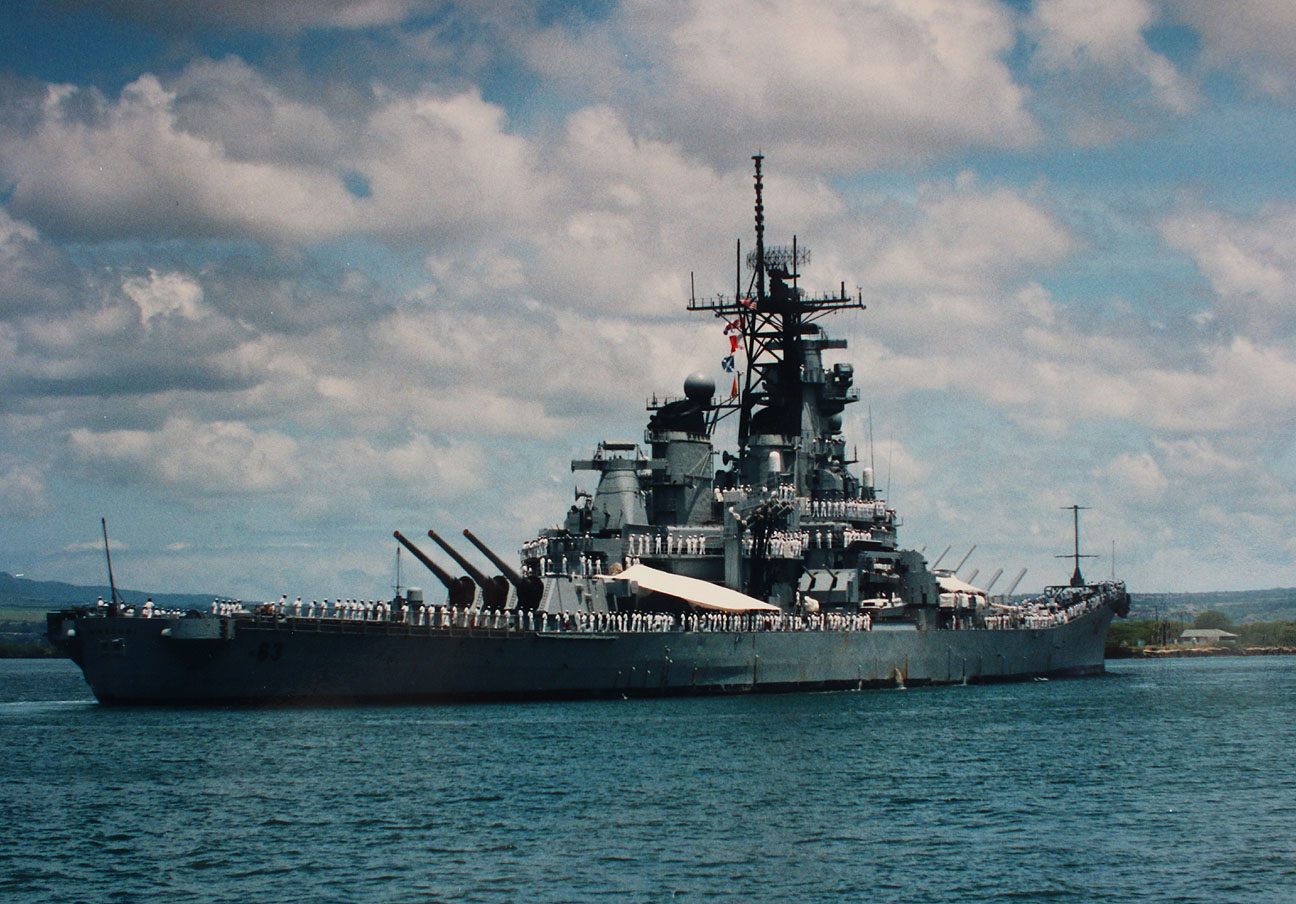
Missouri enters Pearl Harbor on her way home from the Persian Gulf
The incredible victory of the Coalition over Saddam's army, one of the greatest in military history, has been covered adequately elsewhere. During her 60 hours supporting the land war, Mighty Mo fired 611 16" rounds, bringing her total for the war to 759. This was over twice what Wisconsin provided, although the other battleship did manage to claim the honor of being the last of the big-gun ships to fire her weapons in anger. Missouri cleared the Persian Gulf on March 21st, ending her third war. Her first stop on the way home was Australia, where she was welcomed with the usual vigor. On May 9th, as she neared Long Beach, she fired her 16" guns for the last time. When she pulled into port, the first aboard were the 50-something babies born to crewmen while she was deployed.

President Bush prepares to come aboard the Missouri, December 7th, 1991
While Wisconsin came directly from the Gulf into preparations for decommissioning, Missouri lingered a bit longer. The ceremony marking the 50th anniversary of the attack on Pearl Harbor was that December, and President Bush came aboard the battleship to commemorate it. Then it was finally time for the last battleship to leave the fleet. On March 31st, 1992, her commissioning pennant was hauled down. We will not see her like again.
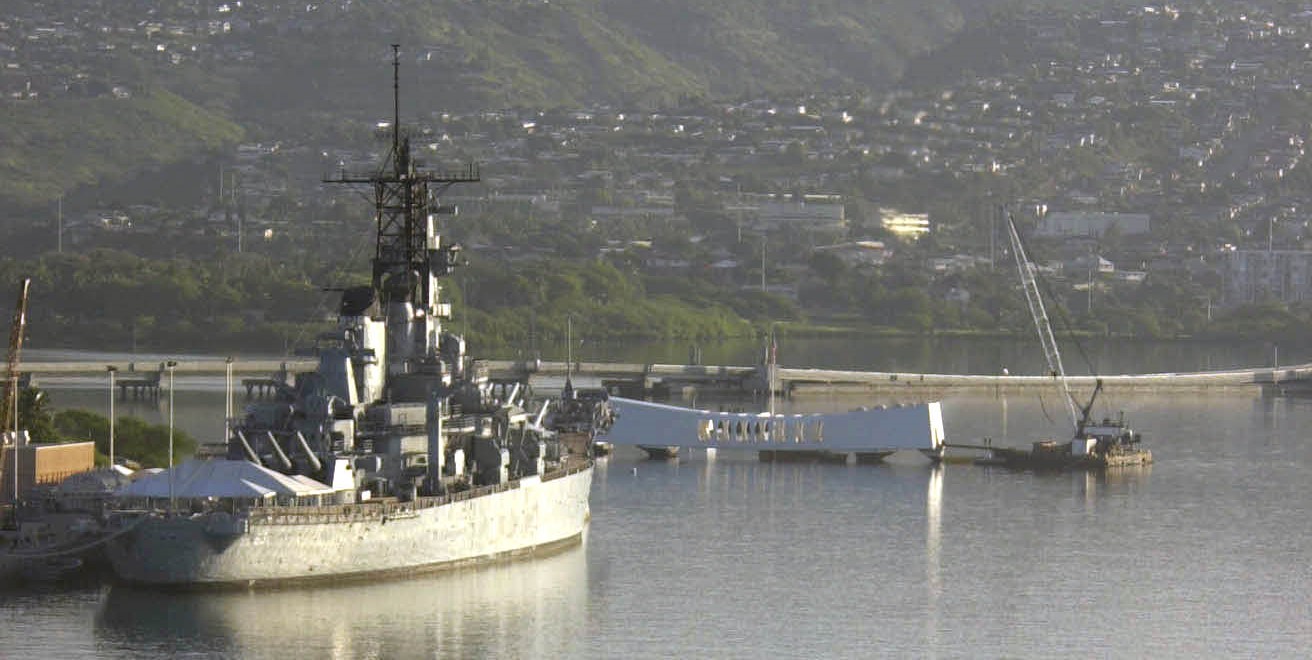
Missouri and the Arizona memorial
Today, Missouri is a museum ship in Hawaii. She is moored on "Battleship Row", right next to the Arizona Memorial.
1 In fairness, it could have happened to a carrier, too. ⇑
3 This means that Missouri was the only one of the Iowas not refitted to carry the Mk23 nuclear projectiles. ⇑
4 This was part of Secretary Lehman's plan to disperse the fleet, making it more survivable and gaining political favor. Diane Feinstein was one of the major advocates of bringing a battleship to the Bay Area, although this was opposed by protestors, some of whom apparently believed that the ship was nuclear-powered. The plan was later cancelled after Lehman left the Pentagon and Feinstein left San Francisco for DC. ⇑
5 Missouri's UNREPs during this period were also distinguished by the unusual method of passing the line. Instead of having a man on deck fire the line from the gun, the captain would train one of the turrets towards the other ship, and then the gunner's mate with the line thrower would emerge from the center gun. ⇑

Comments
When the Korean War broke out in mid-1950, I was in Company 107 at the Great Lakes Training Center in Illinois! A couple weeks before graduation our Company was merged with Company 106. We knew something was up, but didn't know what!
A week later, all post-graduation orders were cancelled and our expanded Company of 100 men were ordered to the battleship USS Missouri. Immediately after graduation, we were troop-trained to Norfolk, VA.
After a night's "Cinderella Liberty" aboard the Naval Base, at 0600 the following morning we marched to Pier 7. Jaws dropped at the first sight of the biggest ship most of us had ever seen, we boarded it at the "after" gangway.
After our 100-man Company were assigned to specific Divisions, we were shown our berthing quarters and assigned lockers in which we stowed our gear.
We were then escorted to the "mess deck" where we enjoyed our first meal aboard this huge battleship.
About an hour or so later, we felt the ship being moved away from the pier by tugboats and then, under the ship's power, we headed for the opening of Chesapeake Bay and the open sea.
I was assigned to the FA Division and soon found myself learning all about the Bofors Quad-40mm Anti-Aircraft guns. Then, I heard the "click" of the 1MC (ship's loudspeakers) and the Skipper's voice told us that we were headed for Korea at best speed. He also told us we were headed for the Panama Locks through Hurricane Alpha which was forming up off the Carolina coast!
Two helicopters and a 1949 Plymouth that were being ferried to Hawaii were washed over the side. After squeezing through the locks at Panama, we headed for San Diego to make repairs caused by the hurricane and to load provisions and ammunition.
We were running behind schedule, so when we departed San Diego, all boilers were "kicked-in" and we were on a fast course for Korean waters!
The weather caused us to arrive too late to participate in the landing at Inchon, so we were ordered to Samchock, North Korea to participate in a diversion. Our bombardment at Samchock might just make the enemy think the invasion was there rather than at Inchon.
Long story shortened, we took part in 19 bombardment missions (two of which were tagged as major battles). We also performed at sea aircraft carrier guard duty and some gunfire support missions. We earned our Combat Action Ribbons during those almost 8 months of continuous bombardment missions!
After two years aboard this beautiful battleship, I decided to change my job in the Navy from guns to typewriters. Capsuling my career, I served 2 years aboard the aircraft carrier USS Forrestal (CVA-59); about 10 years in various NATO headquarters (including two 3-year tours in Paris, France and Brussels, Belgium) and several shore duty assignments stateside!
I retired on 1 November 1973 as a Senior Chief Petty Officer (E-8). I didn't see the "Might Mo" again for more than 50 years. My fiancé and I decided to get married on the beach in Hawaii. On the flight to Hawaii, Cathy said, "wouldn't it be great to get married on your old battleship?" (The ship was now a museum, permanently tied up to a pier on Ford Island in Pearl Harbor.
Low and behold, we were given special permission to have our ceremony aboard the ship - first time a former crewmember had ever been married on board, and no marriage ceremonies were permitted since1
When we arrived back in Pensacola, Florida, we pondered on the idea of moving to Hawaii! Six months later we had sold our home and were headed for Hawaii.
We were accepted as volunteers aboard the Might Mo! We stayed in Hawaii for 8 years. I was designated as a Volunteer Supervisor. I was also named as Director of the Missouri Memorial Association's Director of the Wounded Warrior Program; the resident speaker for onboard visitors and at most of the Navy commands on the island of Oahu. I had the honor of being selected Keynote speaker on Veterans Day (11/11/2011). I was also asked to be the regular speaker during the CPO Legacy Academy held aboard the ship annually! I had the singular honor to be asked to be the Keynote Speaker at the Korean War Veterans Awards Ceremony in Seoul, South Korea in 2013.
Because I was a crewmember aboard the Missouri during the Korean War, I was asked by Director Peter Berg if I would like to be an Extra in the movie, "Battleship," which was being filmed aboard the ship. The scenes I appeared in were in the final production of the film.
I am 86 years young now and my wife, Cathy, and I reside at Hot Spring Village in the Arkansas mountains!
I can be reached at bwoutland@yahoo.com and/or at our home at 144 Castano Drive, HSV, AR 71909 for more information.
I highly recommend you tour my old ship in Pearl Harbor, next time you're in the area.
Thank you for sharing. It's very cool to hear from former battleship crew.
The one thing that jumped out to me is your wedding being the only one ever on the Missouri. Why is that? Iowa does lots of events, including weddings, because they pay well. (Unpleasant fact of life in the museum ship world.) Are Missouri's visitor numbers really high enough that doing them doesn't make sense/isn't necessary?
From their online publications, it seems like the Mighty Mo does plenty of weddings these days for service members and vets. They even have separate package tiers.
https://ussmissouri.org/documents/Military-Weddings-2019-for-website.pdf
I'm still slightly surprised they'd limit it to the military/veterans, but I could see that being a large enough pool (what with Hawaii being a destination and all) to give them as many weddings as they actually want to do.
There are multiple versions of the 1991 missile attack. Some say that Missouri's 16"/50s destroyed the missile launch site; some say this site was destroyed by aircraft, and that Missouri destroyed a different missile site on a different day.
Some versions have Missouri's 5"/38s firing (unsuccessfully) at the missile itself, but those seem to trace to one account by someone who was there but was speaking from memory years later, which is obviously an error-prone source. Given the 5"/38's record against airplanes, and similar systems against V-1s, it would plausibly have a ~5% chance of working with all 6 guns on that side ready and a crew who had practiced for it. (The Mk25 radar is auto-tracking, so it doesn't require the fine aiming skill of the 1940s original, but it does require quickly getting onto target and preferably quick loading. And it's still a mechanical computing system on a rolling ship, while the main anti-V-1 systems were analog electronic and at stationary land sites.) This is plausibly not worth keeping that many more people on watch, and in a likely impact area if the ship does get hit. (The shore was out of 5"/38 range, so these guns wouldn't have been in use for bombardment.)
There's something romantic about the battleships' last mission, so long after they became obsolete enough that they stopped being built, still finding one in a life-or-death fight with no better option than her own guns. (Even the versions with 2 missile sites do count as that: a site that hasn't fired yet is still a threat, and possibly more so than one that has just fired and missed.) The invention of GPS-guided weapons plausibly made this about the last point in history where that was likely.